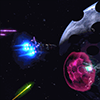whenever I see beautiful renders like these, I wonder how complex light sources are handled within a Deferred Rendering context.

I have implemented point, spot and direction lights just fine, but look at the light source in the top right corner, how is this done? Is it just a white material that doesn't get affected by shading whatsoever (so it pretty much stays all white) and then a point light underneath to give the effect of a rectangular light source?
I've seen other games have stripes on the ground that illuminated the level, how is this done? Can all lights in real-life be simulated by just point, spot and directional lights somehow? Or is there a (set of) special technique(s) that help us out here (something like "surface lights" or illuminating materials like in 3DS MAX)?
Think of a ceiling light that is very narrow but extremely long, like this one for example:

Is this just an array of point lights along the light source?
This is something that's been bothering me for a while, I was never able to find anything, search doesn't give results (probably due to not having the proper keywords) and I've never seen a lighting tutorial go past the point, spot and direction light types.
Please enlighten me (pun intended hur hur hur)! Thanks ahead of time!







